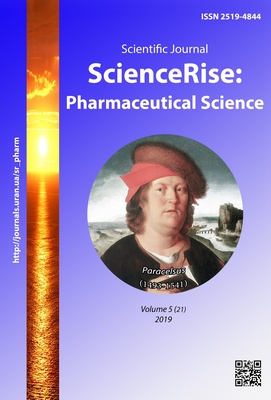Study of structural and mechanical properties of bases in the development of dental gel with combined composition
DOI:
https://doi.org/10.15587/2519-4852.2019.182398Keywords:
gel, gelling agent, carbomer, rheology, viscosity, dental drugAbstract
Aim. The development of the composition of the dental gel for the treatment of infectious and inflammatory diseases of the oral cavity, taking into account the physicochemical properties of the active pharmaceutical ingredients, namely the justification of the type and concentration of the gelling agent and other excipients.
Methods. The determination of organoleptic characteristics, uniformity of gel samples, pH of aqueous extract, and structural viscosity index was carried out according to the methods of the State Pharmacopoeia of Ukraine. Rheological studies were carried out using a rotational viscometer of the rotating type BROOKFIELD DV-II + PRO (USA) with a coaxial cylinder system.
Results. In order to choose the optimal composition of the gel base, experimental samples with various gelling agents were developed (Carbopol 974P, Carbopol 934P, Carbopol Ultrez 10, xanthan gum, sodium alginate, sodium carmellose) and their organoleptic characteristics, structural viscosity and colloidal stability were studied. The physicochemical and rheological studies that were carried out, allowed us to conclude that it is rational to use the Carbopol Ultrez 10 gel former at a concentration of 1.1 %. When choosing neutralizing agents, sodium hydroxide and trometamol were used in the studies. According to the results of studies, sodium hydroxide at a concentration of 0.32 % was selected as a neutralizer, which provides maximum, stable viscosity in the pH range from 5.0 to 7.0.
Concusions. The composition of the basis of a dental gel for the treatment of infectious and inflammatory diseases of the oral cavity has been developed: Carbopol Ultrez 10 - 1.1 %, sodium hydroxide solution 10 %–0.32 %
References
- Artiushkevich, A. S. (2006). Zabolevaniia periodonta. Moscow: Medicinskaia literatura, 306.
- Lukianchuk, V. D., Hordiichuk, D. O. (2015). Suchasnyi stan pytannia patohenezu parodontytu ta yoho farmakokorektsii (ohliad literatury). Medytsyna sohodni i zavtra, 2 (67), 14–22.
- Kingman, A., Albandar, J. M. (2002). Methodological aspects of epidemiological studies of periodontal diseases. Periodontology 2000, 29 (1), 11–30. doi: http://doi.org/10.1034/j.1600-0757.2002.290102.x
- Tüzüner, T., Ulusoy, A. T., Baygin, O., Yahyaoglu, G., Yalcin, I., Buruk, K., Nicholson, J. (2013). Direct and Transdentinal (Indirect) Antibacterial Activity of Commercially Available Dental Gel Formulations againstStreptococcus mutans. Medical Principles and Practice, 22 (4), 397–401. doi: http://doi.org/10.1159/000347234
- Vynohradova, O. M. (2013). Vykorystannia suchasnykh antymikrobnykh i protyzapalnykh preparativ mistsevoi dii v likuvanni zapalnykh zakhvoriuvan parodontu. Zdobutky klinichnoi i eksperymentalnoi medytsyny, 2, 47–49.
- Mazur, I. P., Peredrii, V. A., Dulko, S. V. (2010). Farmakolohichni zasoby dlia mistsevoho likuvannia tkanyn parodontu. Sovremennaia stomatolohyia, 5, 47–52.
- Derzhavna farmakopeia Ukrainy. Vol. 2 (2014). Kharkiv: Derzhavne pidpryiemstvo «Naukovo-ekspertnyi farmakopeinyi tsentr yakosti likarskykh zasobiv», 724.
- European Pharmacopoeia (2016). EDQM. Strasbourg: Council of Europe, 4016.
- Rescala, B., Rosalem, W., Teles, R. P., Fischer, R. G., Haffajee, A. D., Socransky, S. S. et. al. (2010). Immunologic and Microbiologic Profiles of Chronic and Aggressive Periodontitis Subjects. Journal of Periodontology, 81 (9), 1308–1316. doi: http://doi.org/10.1902/jop.2010.090643
- Davtian, L. L. (2006). Naukovo-praktychne obgruntuvannia tekhnolohii miakykh likarskykh form dlia stomatolohii. Kyiv, 304.
- Ofner, C. M., Klech-Gelotte, C. M.; Swarbrick, J., Boylan, J. C. (Eds.) (2002). Gels and jellies. Encyclopedia of Pharmaceutical Tehnology. Vol. 2. NewYork: Basel: MarselDekker, 1327–1344.
- Rahman, M. N. A., Qader, O. A. J. A., Sukmasari, S., Ismail, A. F., Doolaanea, A. A. (2017). Rheological Characterization of Different Gelling Polymers for Dental Gel Formulation. Journal of Pharmaceutical Sciences and Research, 9 (12), 2633–2640.
- Rowe, R. C., Sheskey, P. J., Cook, W. G., Fenton, M. E. (Eds.) (2012). Hand book of Pharmaceutical Excipients. London:Pharmaceutical Press, 1064.
- Volovyk, N. V. (2008). Rozrobka i standartyzatsiia protyzapalnykh preparativ u formi heliv. Kharkiv, 20.
- Islam, M. T., Rodríguez-Hornedo, N., Ciotti, S., Ackermann, C. (2004). Rheological Characterization of Topical Carbomer Gels Neutralized to Different pH. Pharmaceutical Research, 21 (7), 1192–1199. doi: http://doi.org/10.1023/b:pham.0000033006.11619.07
- Carbopol® Ultrez 10 Polymer (2002). Technical Data Sheet (TDS-225). Lubrizol: Cleveland.
- Carbopol® Ultrez 21 Polymer (2002). Technical Data Sheet (TDS-297). Lubrizol: Cleveland.
- Malkin, A. IA., Isaev, A. I. (2007). Reologiia: koncepcii, metody, prilozheniia. Saint Petersburg: Professiia, 557.
- Aupova, R., Sakipova, Z., Zemlicka, M. (2014). Study of rheological properties of carbomer gels. Life Science Journal, 11, 25–27.
- Gladukh, Ie. V., Grubnik, I. M., Kukhtenko, G. P., Stepanenko, S. V. (2015). Rheological studies of water-ethanol solutions of gel-formers. Journal of Chemical and Pharmaceutical Research, 7 (4), 729–734.
- Davtian, L. L., Vashchuk, V. A., Polyshchuk, Yu. P. (2013). Reolohichni doslidzhennia yak osnova tekhnolohichnoho protsesu u razi stvorennia novoho likarskoho zasobu. Farmatsevtychnyi zhurnal, 4, 52–58.
- Singh, V. K., Anis, A., Banerjee, I., Pramanik, K., Bhattacharya, M. K., Pal, K. (2014). Preparation and characterization of novel carbopol based bigels for topical delivery of metronidazole for the treatment of bacterial vaginosis. Materials Science and Engineering: C, 44, 151–158. doi: http://doi.org/10.1016/j.msec.2014.08.026
- United States Pharmacopeia and National Formulary 2017 [USP 40 – NF35] (2016). Rockville: UnitedStatesPharmacopeialConvention, Inc, 7970.
- Opredelenie sposoba vvedeniia v osnovu aktivnykh farmacevticheskikh ingredientov stomatologicheskogo gelia (2019). Aktualnye problemy sovremennoi mediciny i farmacii. Minsk, 1545.
Downloads
Published
How to Cite
Issue
Section
License
Copyright (c) 2019 Volodymyr Yakovenko, Dmytro Orlenko, Liliia Vyshnevska

This work is licensed under a Creative Commons Attribution 4.0 International License.
Our journal abides by the Creative Commons CC BY copyright rights and permissions for open access journals.








